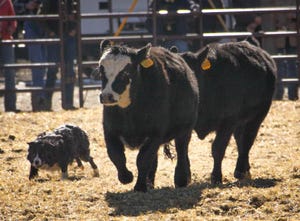June 23, 2015

I recently read a blog written by Michaela Mann, who was one of my peers at South Dakota State University. In her blog post for Ranch House Designs, Mann lists the top five reasons every cattleman needs a cow dog, citing that these four-legged ranch hands are loyal, hard-working, intelligent, forgiving, and a source of selfless friendship.
READ: 5 reasons why every cattleman needs a cattle dog
Mann writes, “A dog is a staple in many households, acting as a loyal companion, a playmate and protector. The role of a family dog takes on a whole new meaning when the dog is also a cattle dog. A cattle dog is a valuable asset to many cattle operations. They help ranchers through the daily work of raising cattle, and at the end of the day, these dogs come home and serve as man’s best friend.”
While having a cattle dog is incredibly rewarding and valuable for many ranch outfits, there is a huge difference between a well-trained dog and one that causes a lot of heartache and frustration when it comes time to work cattle. A few years ago, I witnessed some of the most athletic and disciplined cattle dogs work alongside their trainers at the National Cattle Dog Finals where I worked as an emcee of the event. On the flip side, I’ve seen some train wrecks while working cattle at the neighbor’s place when a poorly trained dog decides to go rouge and not listen to instructions from its owners.
READ: A new puppy teaches this old dog new tricks
Here are three tips for training a cattle dog to be a valuable member of the ranch from Tim Naasz, a national champion dog trainer and South Dakota cattleman:

Photo Credit: Tim Naasz
“You don’t have to spend a lot of money to get a good dog,” says Naasz. “When shopping for a dog, especially one that isn’t papered, make sure you can look at the parents and see what they are doing. You want to see that the parents are actually working cattle dogs. When I invest in a dog, I want it to work. Ask the trainer or owner when the dog ‘turned on,’ which means, when did he mature and have the desire to work stock? Do your homework ahead of time before making a purchase.”
VIEW: 180+ photos of ranch dogs
2. Take a 4-H obedience class with your dog.
“I highly recommend the dog takes a 4-H obedience class with a kid in the first year,” advises Naasz. “The classes help socialize the dog to be in new situations and around other people. I have found that the more you socialize the dog, the better they can be as a stock dog because new and different situations don’t bother them as much. You can easily take them to trials or to work cattle at the neighbor’s, and the new area won’t bother them. Some dogs get leery of situations outside of their comfort zones, so it’s important to train them early and also not to be nervous when working.”
READ: Lessons a ranch kid learns from his dog, horse and cattle
3. Understand low-stress cattle handling.
“I try to practice low-stress cattle handling,” says Naasz. “The way you handle your dog directly impacts how the cattle respond. The quieter you can be with your dog, the better it is for your cattle. You want to teach your dog to be confident when working cattle, but not overly aggressive. It’s stressful to have a dog that’s constantly biting at the heels of the stock. In a small control area when training, you can teach a dog not to be so aggressive.”
Naasz also recommends introducing a cattle dog to the cow herd slowly to get the livestock and the pup acclimated to each other. He says a dog’s best years are between four and eight, and patience and practice are the keys to making a stock dog a good one.
Do you utilize cattle dogs on your ranch? Which breed do you prefer? What is your best advice for training? Share with us in the comments section below.
The opinions of Amanda Radke are not necessarily those of beefmagazine.com or Penton Agriculture.
You might also like:
60 stunning photos that showcase ranch work ethics
7 tools to win the war against cattle flies
Is agriculture the bad boy in the nation's water use?
Proper timing & products needed for deworming pasture cattle
You May Also Like



